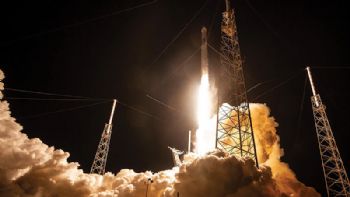
On 23 May, SpaceX launched 60 Starlink satellites from Space Launch Complex 40 at Cape Canaveral Air Force Station, Florida.
Starlink is a next-generation satellite network capable of “connecting the globe — especially those who are not yet connected — with reliable and affordable broadband Internet services”.
The Falcon 9’s first stage used for this mission previously supported the Telstar 18 Vantage mission in September 2018 and the Iridium-8 mission in January this year.
Following stage separation, it landed on a ‘drone-ship’ that was stationed in the Atlantic Ocean. About 62min after lift-off, the Starlink satellites were deployed at an altitude of 440km.
They then used onboard propulsion to reach their operational altitude of 550km.
SpaceX designed Starlink to connect end users with ‘low-latency high-bandwidth’ broadband services by providing continual coverage around the world, using a network of thousands of satellites in a low orbit.
To design and manufacture a constellation of this scale, SpaceX is using the same ‘rapid iteration’ approach that led to the success of the Falcon 1, Falcon 9, Falcon Heavy and Dragon.
Starlink’s simplified design is “significantly more scalable and capable than its first experimental iteration”.
With a flat-panel design featuring multiple high-throughput antennas and a single solar array, each Starlink satellite weighs about 227kg.
To adjust position on orbit, maintain the intended altitude and de-orbit, each satellite features Hall thrusters powered by krypton; it also has a navigation system that allows SpaceX to precisely orient it, track on-orbit debris and autonomously avoid collision.